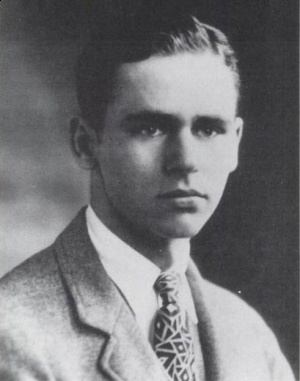Difference between revisions of "James Agee"
Sorindanut (talk | contribs) |
Sorindanut (talk | contribs) |
||
| Line 1: | Line 1: | ||
| + | {{Infobox artist | ||
| + | |image = Agge_young.JPG | ||
| + | |imagesize = 300px | ||
| + | |caption = James Agee | ||
| + | |birth_date = {{birth date|1909|11|27|mf=y}} | ||
| + | |birth_place = Knoxville, Tennessee, U.S. | ||
| + | |death_date = {{Death date and age|1955|5|16|1909|11|27|mf=y}} | ||
| + | |death_place = New York City, New York, U.S. | ||
| + | }} | ||
| + | |||
'''James Rufus Agee''' (November 27, 1909 – May 16, 1955) was an American journalist, poet, novelist, screenwriter and film critic. Pulitzer Prizewinner (1958) for poshumous novel ''A death in the Family'' (1957). | '''James Rufus Agee''' (November 27, 1909 – May 16, 1955) was an American journalist, poet, novelist, screenwriter and film critic. Pulitzer Prizewinner (1958) for poshumous novel ''A death in the Family'' (1957). | ||
Agee is best known for ''Let Us Now Priase Famous Men'' (published 1941, written 1936-40), a prose account of 8 months visiting poor Alabama families in 1936 with photographer [[Walker Evans]], whose pictures are integral to the project. | Agee is best known for ''Let Us Now Priase Famous Men'' (published 1941, written 1936-40), a prose account of 8 months visiting poor Alabama families in 1936 with photographer [[Walker Evans]], whose pictures are integral to the project. | ||
Revision as of 07:22, 5 December 2013
 James Agee | |
| Born |
November 27, 1909 Knoxville, Tennessee, U.S. |
|---|---|
| Died |
May 16, 1955 (aged 45) New York City, New York, U.S. |
James Rufus Agee (November 27, 1909 – May 16, 1955) was an American journalist, poet, novelist, screenwriter and film critic. Pulitzer Prizewinner (1958) for poshumous novel A death in the Family (1957). Agee is best known for Let Us Now Priase Famous Men (published 1941, written 1936-40), a prose account of 8 months visiting poor Alabama families in 1936 with photographer Walker Evans, whose pictures are integral to the project.
"If I could do it, I’d do no writing at all here. It would be photographs; the rest would be fagments of cloth, bits of cotton, lumps of earth, records of speech, pieces of wood and iron, phials of odors, plates of food and excrement. Booksellers would consider it quite a novelty; critics would murmur, yes, but is it art; and I could trust a majority of you to use it as you would a parlor game..." (wrote Agee in Let Us Now Praise Famous Men).
About Agee
- Articles
- Charles Gregory, William Dorman, "The Children of James Agee", JOURNAL OF POPULAR CULTURE, Vol. 9, no. 4, 1976:996-1002.
- Victor A. Kramer, "American Silences: The Realism of James Agee, Walker Evans,
and Edward Hopper (review)", MFS Modern Fiction Studies, Vol. 31, no. 4, (Winter 1985):753-754.
- Books
- Huse, Nancy Lyman, John Hersey and James Agee: A Reference Guide, Boston: G.K. Hall & Co., 1978.
- Kramer, Victor A., James Agee, Boston: Twayne Publishers, 1975.
- Kramer, Victor A. (ed.), Agee: Selected Literary Documents, Troy, N.Y.: The Whitston Publishing Company, 1996.
- Caroline Blinder (ed.), New Critical Essays on James Agee and Walker Evans: Perspectives on Let Us Now Praise Famous Men, N.Y.: Palgrave Macmillan, 2010.
- Durden, Mark (ed.), Fifty Key Writers on Photography, N.Y.:Routlledge, 2013.